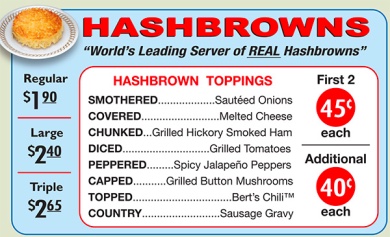:format(webp)/cdn0.vox-cdn.com/uploads/chorus_image/image/54576575/9799063865_dcd1210742_k.0.0.jpg)

No 24-hour diner chain inspires quite the same cult following as Waffle House. Since its founding in Atlanta some 60 years ago, the restaurant has been elevated to cultural touchstone, now sprawling across 25 U.S. states with more than 2,000 locations.
Slinging humble breakfast fare around the clock, Waffle House inspires deep and unyielding loyalty in diners like few restaurant chains (except maybe Whataburger) can. Is it the cheap prices? The no-frills atmosphere? Those illustrious hash browns that somehow taste better when youre intoxicated? The waitresses that inevitably call you honey? Likely some combination of all of the above, plus a little bit of that inexplicable Southern diner magic call it the Waffle House je ne sais quoi.
The chain has inspired numerous books, including a first-person narrative from a former line cook titled As the Waffle Burns as well as one by a pastor called naturally The Gospel According to Waffle House. The chain, which claims to have sold its billionth waffle sometime in 2015, recently saw both of its founders, Tom Forkner and Joe Rogers Sr., die within just two months of one another. Here now, a look back at the legend, and for fans near and far, everything you need to know about Waffle House.
The first Waffle House made its debut in 1955 in the Atlanta suburb of Avondale Estates. The vision: combine fast food, available 24 hours a day, with table service. Co-founder Forkner once explained how he and Rogers, who were neighbors, started the chain: He said, You build a restaurant and Ill show you how to run it. They named it Waffle House because waffles were the most profitable menu item (and therefore, what they most wanted customers to order).
Eating at Waffle House for the first time requires becoming versed in a new vernacular what the hell does scattered, smothered, and covered mean? True Waffle House devotees have their hash brown orders committed to memory, but for everyone else, the menu translates each esoteric term: Scattered refers to spreading the hash browns out across the grill so they get crispy all around otherwise, theyre cooked inside a steel ring and is one of the mostly commonly heard terms thrown around at WH; many also order them well-done. The other topping options are smothered (sautéed onions), covered (melted American cheese), chunked (bits of ham), diced (tomatoes), peppered (jalapeños), capped (grilled mushrooms), topped (chili), or country (smothered in sausage gravy). Diners can also just say to hell with it and order them all the way.
Like most any other diner, orders at Waffle House are subject to plenty of customization, from the various egg preparations (over easy, scrambled, et al) to those signature hash browns. To ensure order accuracy and kitchen efficiency, Waffle House staff have their own highly esoteric visual coding system. By marking plates with butter pats, mini tubs of grape jelly, and other condiments such as mayo packets and pickles in various, highly specific arrangements, servers are able to communicate to cooks what food should be prepared for each plate. For example, to indicate an order of scrambled eggs with wheat toast, a tub of jelly is placed on a larger oval plate upside down at the six o'clock position. (Good luck memorizing this system unless you actually work there; the rest of us will simply have to look on with awe.)
Despite all his globe-trotting, Anthony Bourdain had apparently never patronized a Waffle House until 2016, when he accompanied Southern chef sensation Sean Brock on a late-night, post-bar feast. No one needs Bourdain to proselytize about the goodness that is Waffle House, but regardless, he had some poetic commentary to offer: It is indeed marvelous an irony-free zone where everything is beautiful and nothing hurts; where everybody regardless of race, creed, color or degree of inebriation is welcomed. (Brock also assembled the ultimate Waffle House tasting menu for Bourdains recently launched travel site, Explore Parts Unknown.)
Video: https://www.youtube.com/watch?v=cX_kbIVxl_o
But the fact that Waffle House is literally always open is also part of what makes it so beloved. In fact, its restaurants close so rarely that at least one government agency uses the diners as a barometer for disaster recovery. The Federal Emergency Management Agency utilizes an informal Waffle House Index to determine the severity of a tropical storm or hurricane. In short, if a Waffle House closes thats a sign to FEMA and to the rest of us that a storm was severe. Here are the three levels of the Waffle House Index, which is used to evaluate areas after a storm passes through:
Green: Waffle House is serving a full menu and electricity is on.
Yellow: Waffle House is serving a limited menu, may be low on food supplies, and is likely using an electrical generator.
Red: Waffle House is closed. (Oh shit, time to panic.)

https://www.eater.com/2017/5/2/15471798/waffle-house-history-menu
Just reading through this makes me wish I was back in Atlanta right now. The ultimate comfort food, whether it's 3pm or 3am.
Scattered, smothered, and diced for me.
